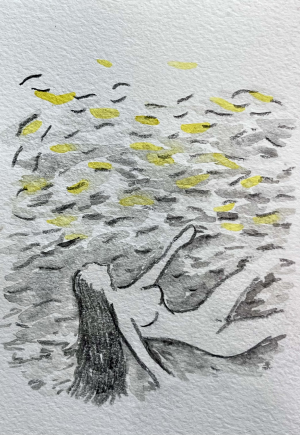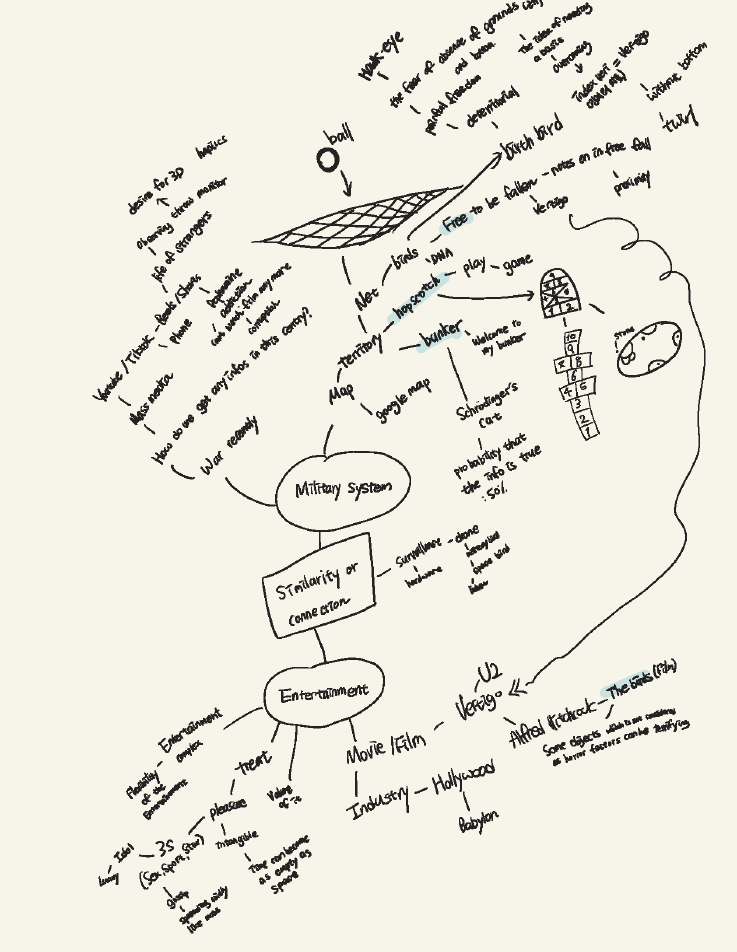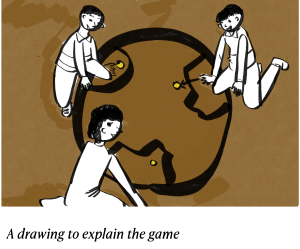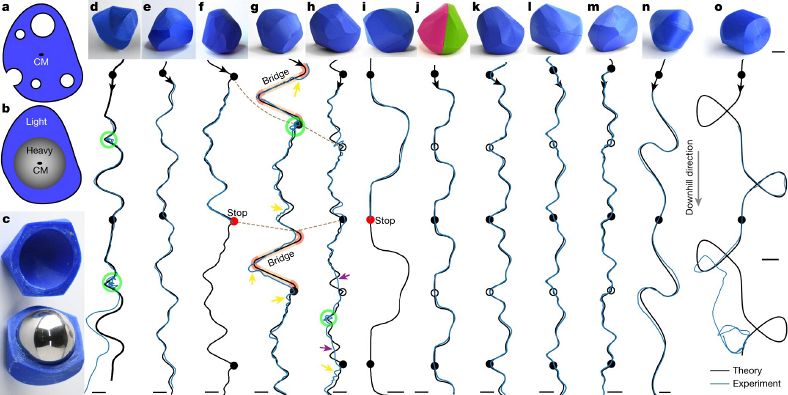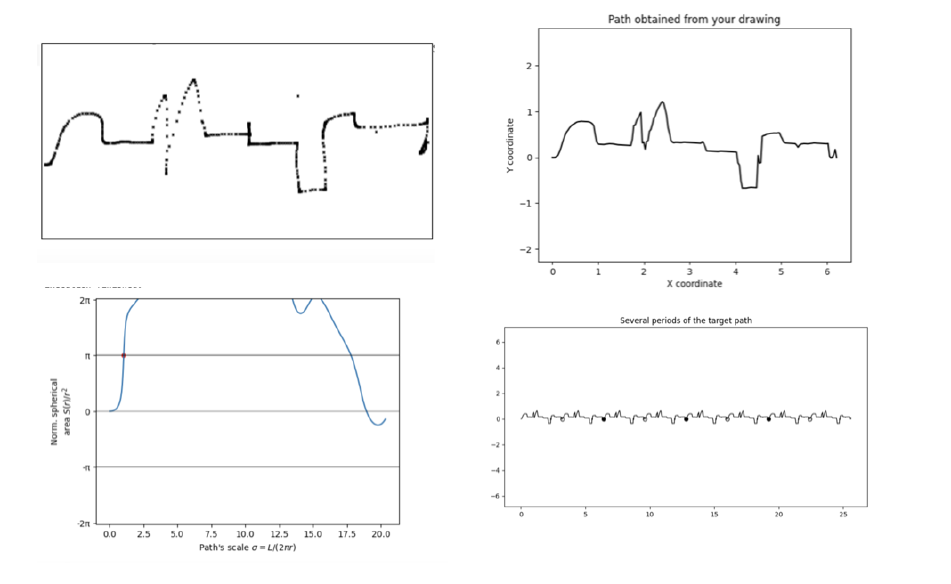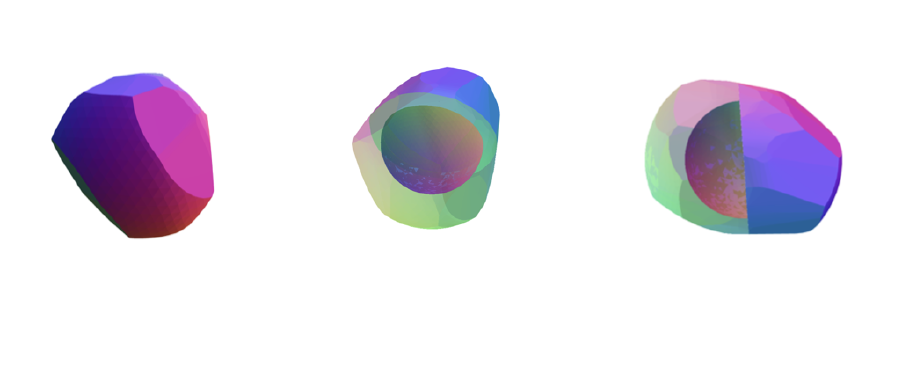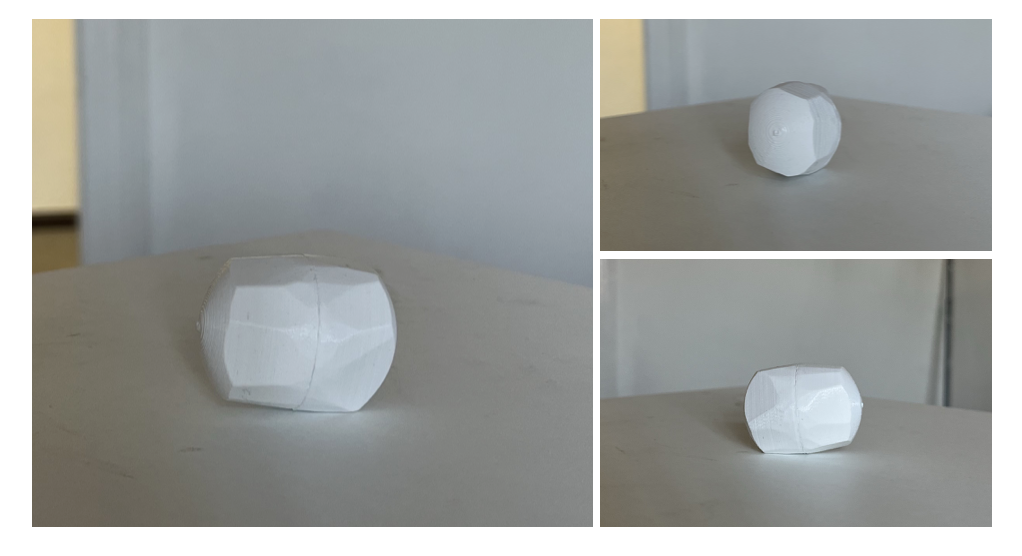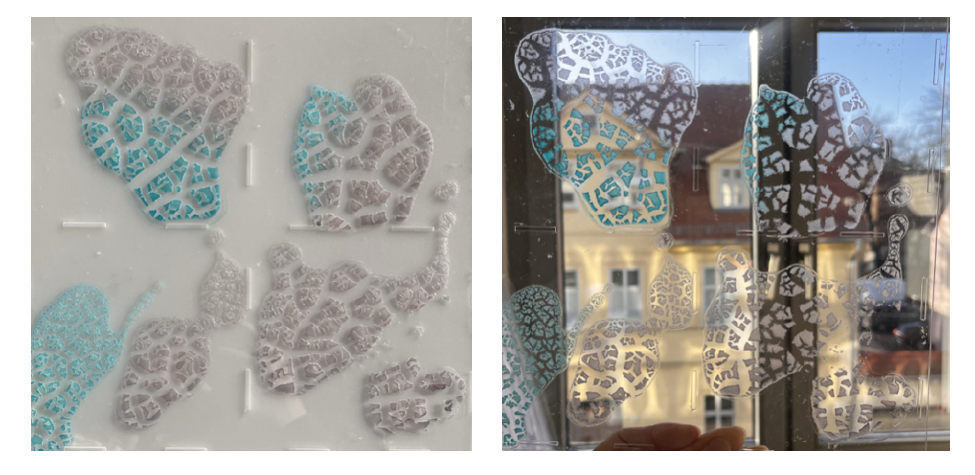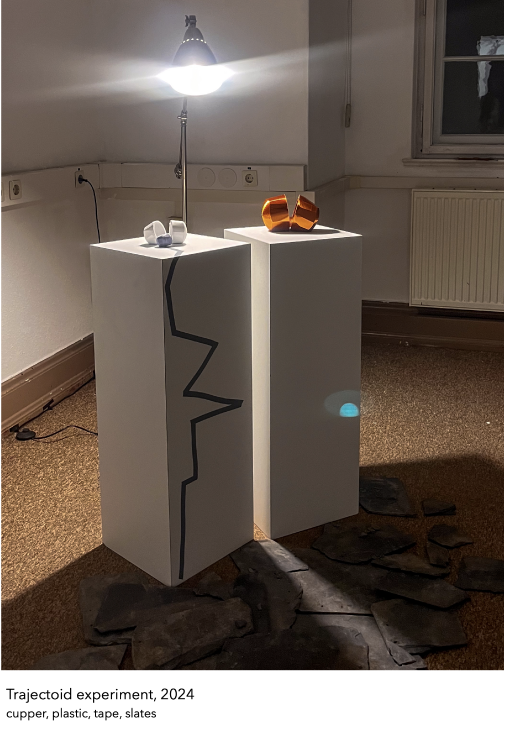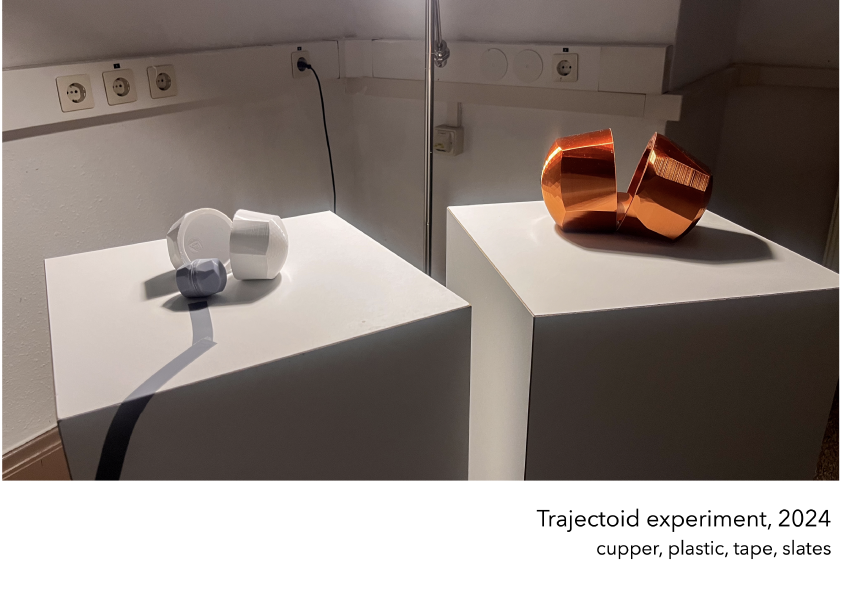No edit summary |
|||
| (20 intermediate revisions by 2 users not shown) | |||
| Line 1: | Line 1: | ||
Diagram ( | |||
[[File: | |||
[[File: | == '''<big>Paidia, Hopscotch</big>''' == | ||
[[File:Falling .png|thumb|left]] | |||
<blockquote> | |||
Bauhaus-University Weimar | |||
2023 Winter semester | |||
Juyoun Oh</blockquote> | |||
This work is inspired by the book | |||
“The Wretched of the Screen”by Hito Styerl | |||
'''“Similarities between military system and entertainment”''' | |||
'''such as GPS''' | |||
'''“…over the past few years, visual culture has become saturated''' | |||
'''with aerial military and entrainment images. ”''' | |||
[[File:Diagram10122023.png|left|thumb|952x952px]] | |||
''Diagram to develop the idea'' | |||
. | |||
In recent decades, our lives have been filled with entertainment spectacles that are unwittingly based on military technology. The book I read prior to this project, "The Wretched of the Screen" by Hito Steyerl, was quite fascinating, and the sections that referenced and explored the parallels between military systems and entertainment provoked profound reflection on the ongoing conflict currently. In particular, there was a passage in the book that referred to "the ongoing Israeli-Palestinian war... (hereinafter omitted)," which was published over a decade ago, made me question whether we can actually escape the repetition of war. I would also like to say that as a citizen born and raised in South Korea, where with constant threat of conflict has exhausted me, but living in the only ceasefire country in the world has subconsciously made me more sensitive to these references than others. | |||
This chain of thoughts made me reflect on the repetition of war and how things are progressing regardless of our efforts, and I felt helpless. It occurred to me that we are like pawns being played for a predetermined game, moving without realising that we are the "pawns" being moved, and I began to play with this helplessness in my work. Based on this reflection, I started to work on interacting with the audience. For this, I decided to make a performance which audiences will be playing or performing inspired by the traditional Korean game of “Hopscotch(Ddangddameokki in Korean)”, which is played with a ball. The rules of the game are as follows. | |||
[[File:Image33.png|left|thumb]] | |||
# Draw a large square or circle. | |||
# Draw a small hand-sized circle in each corner. | |||
# Each player bounces the ball three times from their piece of land, and if it bounces back to their piece of land, that piece of land becomes theirs. | |||
# If the ball doesn't return to your land within three bounces, it's your opponent's turn. | |||
# The game continues until there is no empty land, and the player with the most land wins. | |||
In this game, participants play with a three-dimensional object named "Trajectoid" as the "piece" of the game. However, this object is a ball that rolls along a predetermined path, symbolising the lack of alternatives to our actions. Despite the illusion of choice, the trajectory of the game is fixed, which reflects our inability to change the predetermined outcome, and the audience's efforts to deviate from the path we've already set for ourselves feel like a futile effort. The participants try their best, but despite the fact that the game is ultimately limited to a predetermined outcome, they do not realise this and continue to try to beat the game, which coincides with the feeling that we are trapped in a cycle of repeated collisions, thus the game maximises the illusion that we have the right to choose and encourages us to think about how our actions affect the determined outcome. | |||
The current stage of the work is to experiment with an object called "Trajectoid" and a map for this game, and we presented this experimental stage at the last Winterwerkschau. The plan is to reach the first stage of completion of this work in the upcoming new semester. | |||
REFERENCE : | |||
'''Book:''' Hito Steyerl. The Wretched of the Screen. Sternberg Press, 2012. | |||
'''Website:''' JooHyeon Heo. “Trajectoids: Creating a shape that rolls along a desired path” Techplore, <nowiki>https://techxplore.com/news/2023-09-trajectoids-desired-path.html</nowiki>. | |||
What is '''trajectoid'''? | |||
[[File:Trajectoids-creating-a.jpg|left|thumb|788x788px]] | |||
. | |||
. | |||
The concept of rolling objects traditionally brings to mind cylinders or spheres that roll in straight lines. However, researchers are exploring unique shapes like oloids and sphericons, which roll in non-linear paths. These shapes are valuable for applications such as moving objects more efficiently or mixing ingredients thoroughly. Scientists have taken this idea further by designing 3D objects, called "trajectoids," that can follow a predetermined path on a slightly inclined table without slipping. The path must be periodic, consisting of identical repeating segments, and never go uphill. The challenge was to create a shape that rolls down the table, precisely following the drawn path. To achieve this, scientists envisioned starting with a smooth basketball covered in flexible material, trimming it to form a custom shape that follows the desired path. They successfully 3D printed these trajectoids and tested them, demonstrating that trajectoids can be designed to complete two path periods for each full revolution. This two-periods-per-revolution property is significant in 3D rotations and has applications in quantum computing and quantum optics. For instance, the Bloch sphere in quantum physics represents quantum states, similar to how a rolling sphere follows a path. The trajectoid algorithm can help verify the accuracy of quantum computers by comparing changes in qubit states to the motion of a rolling trajectoid. | |||
Additionally, this mathematical insight has implications for MRI technology. Proton spin states in MRI are analogous to trajectoid orientation. By understanding how proton spins return to their original state after specific radio wave pulses, scientists can improve MRI accuracy and disease diagnosis. | |||
Researchers have even provided an online tool for generating 3D-printing files for custom trajectoids, encouraging further experimentation and application of this fascinating concept. | |||
'''Process''' | |||
First step. To design the '''path''' of the trajectoid | |||
[[File:Firststep.png|left|thumb|951x951px]] | |||
. | |||
. | |||
. | |||
Second step. To generate the program for making trajectoid in '''3D Process''' | |||
[[File:Bildschirmfoto 2024-07-26 um 11.19.51.png|left|thumb|902x902px]] | |||
Third step. To 3D print the object | |||
[[File:Bildschirmfoto 2024-07-26 um 11.19.57.png|left|thumb|1022x1022px]] | |||
Forth step. Map experiment with agar | |||
[[File:Bildschirmfoto 2024-07-26 um 11.20.01.png|left|thumb|975x975px|....]] | |||
'''Exhibition for the winterwerkschau 2023''' | |||
[[File:Image-exbihition1.png|left|thumb|745x745px]] | |||
[[File:Image-winterwerkschau.png|left|thumb|841x841px]] | |||
. | |||
. | |||
. | |||
. | |||
. | |||
== References == | |||
First opium war -- connection to social media as a drug | |||
Faraday cage -- idea for a bunker | |||
Aldous Huxley -- Brave New World (New Longman Literature), the drug SOMA | |||
survailance cameras -- pigeon camera used in ww2 | |||
dehumanising war | |||
Latest revision as of 10:27, 26 July 2024
Paidia, Hopscotch
Bauhaus-University Weimar2023 Winter semester
Juyoun Oh
This work is inspired by the book
“The Wretched of the Screen”by Hito Styerl
“Similarities between military system and entertainment”
such as GPS
“…over the past few years, visual culture has become saturated
with aerial military and entrainment images. ”
Diagram to develop the idea
.
In recent decades, our lives have been filled with entertainment spectacles that are unwittingly based on military technology. The book I read prior to this project, "The Wretched of the Screen" by Hito Steyerl, was quite fascinating, and the sections that referenced and explored the parallels between military systems and entertainment provoked profound reflection on the ongoing conflict currently. In particular, there was a passage in the book that referred to "the ongoing Israeli-Palestinian war... (hereinafter omitted)," which was published over a decade ago, made me question whether we can actually escape the repetition of war. I would also like to say that as a citizen born and raised in South Korea, where with constant threat of conflict has exhausted me, but living in the only ceasefire country in the world has subconsciously made me more sensitive to these references than others.
This chain of thoughts made me reflect on the repetition of war and how things are progressing regardless of our efforts, and I felt helpless. It occurred to me that we are like pawns being played for a predetermined game, moving without realising that we are the "pawns" being moved, and I began to play with this helplessness in my work. Based on this reflection, I started to work on interacting with the audience. For this, I decided to make a performance which audiences will be playing or performing inspired by the traditional Korean game of “Hopscotch(Ddangddameokki in Korean)”, which is played with a ball. The rules of the game are as follows.
- Draw a large square or circle.
- Draw a small hand-sized circle in each corner.
- Each player bounces the ball three times from their piece of land, and if it bounces back to their piece of land, that piece of land becomes theirs.
- If the ball doesn't return to your land within three bounces, it's your opponent's turn.
- The game continues until there is no empty land, and the player with the most land wins.
In this game, participants play with a three-dimensional object named "Trajectoid" as the "piece" of the game. However, this object is a ball that rolls along a predetermined path, symbolising the lack of alternatives to our actions. Despite the illusion of choice, the trajectory of the game is fixed, which reflects our inability to change the predetermined outcome, and the audience's efforts to deviate from the path we've already set for ourselves feel like a futile effort. The participants try their best, but despite the fact that the game is ultimately limited to a predetermined outcome, they do not realise this and continue to try to beat the game, which coincides with the feeling that we are trapped in a cycle of repeated collisions, thus the game maximises the illusion that we have the right to choose and encourages us to think about how our actions affect the determined outcome.
The current stage of the work is to experiment with an object called "Trajectoid" and a map for this game, and we presented this experimental stage at the last Winterwerkschau. The plan is to reach the first stage of completion of this work in the upcoming new semester.
REFERENCE :
Book: Hito Steyerl. The Wretched of the Screen. Sternberg Press, 2012.
Website: JooHyeon Heo. “Trajectoids: Creating a shape that rolls along a desired path” Techplore, https://techxplore.com/news/2023-09-trajectoids-desired-path.html.
What is trajectoid?
.
.
The concept of rolling objects traditionally brings to mind cylinders or spheres that roll in straight lines. However, researchers are exploring unique shapes like oloids and sphericons, which roll in non-linear paths. These shapes are valuable for applications such as moving objects more efficiently or mixing ingredients thoroughly. Scientists have taken this idea further by designing 3D objects, called "trajectoids," that can follow a predetermined path on a slightly inclined table without slipping. The path must be periodic, consisting of identical repeating segments, and never go uphill. The challenge was to create a shape that rolls down the table, precisely following the drawn path. To achieve this, scientists envisioned starting with a smooth basketball covered in flexible material, trimming it to form a custom shape that follows the desired path. They successfully 3D printed these trajectoids and tested them, demonstrating that trajectoids can be designed to complete two path periods for each full revolution. This two-periods-per-revolution property is significant in 3D rotations and has applications in quantum computing and quantum optics. For instance, the Bloch sphere in quantum physics represents quantum states, similar to how a rolling sphere follows a path. The trajectoid algorithm can help verify the accuracy of quantum computers by comparing changes in qubit states to the motion of a rolling trajectoid.
Additionally, this mathematical insight has implications for MRI technology. Proton spin states in MRI are analogous to trajectoid orientation. By understanding how proton spins return to their original state after specific radio wave pulses, scientists can improve MRI accuracy and disease diagnosis.
Researchers have even provided an online tool for generating 3D-printing files for custom trajectoids, encouraging further experimentation and application of this fascinating concept.
Process
First step. To design the path of the trajectoid
.
.
.
Second step. To generate the program for making trajectoid in 3D Process
Third step. To 3D print the object
Forth step. Map experiment with agar
Exhibition for the winterwerkschau 2023
.
.
.
.
.
References
First opium war -- connection to social media as a drug
Faraday cage -- idea for a bunker
Aldous Huxley -- Brave New World (New Longman Literature), the drug SOMA
survailance cameras -- pigeon camera used in ww2
dehumanising war
